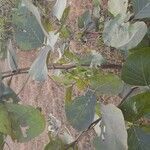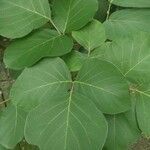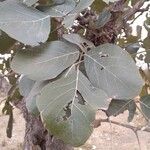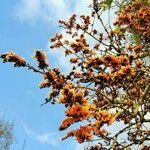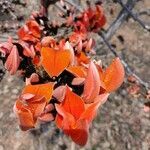| Therapeutic use
|
Abdominal neoplasms (bark), Abdominal pain (bark), Abortifacient agents (bark), Acne vulgaris (bark), Amenorrhea (bark), Analgesics (bark), Anorexia (bark), Anthelmintics (bark), Anti-bacterial agents (bark), Antifungal agents (bark), Anti-inflammatory agents (bark), Antineoplastic agents (bark), Aphrodisiacs (bark), Appetite stimulants (bark), Asthma (bark), Astringents (bark), Celiac disease (bark), Colic (bark), Common cold (bark), Contusions (bark), Diabetes mellitus (bark), Diarrhea (bark), Diuretics (bark), Dysentery (bark), Dysmenorrhea (bark), Dyspepsia (bark), Disorder of ejaculation (bark), Emollients (bark), Erysipelas (bark), Fever (bark), Fractures, bone (bark), Furunculosis (bark), Gonorrhea (bark), Hematuria (bark), Hemorrhage (bark), Hemorrhoids (bark), Hemostatics (bark), Insecticides (bark), Intestinal diseases, parasitic (bark), Laxatives (bark), Liver diseases (bark), Menstruation disturbances (bark), Neoplasms (bark), Pharyngitis (bark), Rectal diseases (bark), General tonic for rejuvenation (bark), Snake bites (bark), Stomach diseases (bark), Hydrocele (bark), Ulcer (bark), Wounds and injuries (bark), Bladder hemorrhage (bark), Malabsorption syndromes (bark), Acne vulgaris (flower), Anthelmintics (flower), Anti-bacterial agents (flower), Antiemetics (flower), Antifungal agents (flower), Anti-infective agents, local (flower), Anti-inflammatory agents (flower), Antipyretics (flower), Antispermatogenic agents (flower), Antitussive agents (flower), Aphrodisiacs (flower), Arthritis (flower), Astringents (flower), Constipation (flower), Contraceptive agents (flower), Contusions (flower), Diarrhea (flower), Diuretics (flower), Dysentery (flower), Dysuria (flower), Edema (flower), Endophthalmitis (flower), Estrogen receptor modulators (flower), Fever (flower), Fractures, bone (flower), Furunculosis (flower), Gonorrhea (flower), Gout (flower), Hematuria (flower), Hemoptysis (flower), Hemorrhage (flower), Hemostasis (flower), Hemostatics (flower), Inflammation (flower), Leprosy (flower), Leukorrhea (flower), Liver diseases (flower), Low back pain (flower), Menorrhagia (flower), Menstruation disturbances (flower), Menstruation-inducing agents (flower), Orchitis (flower), Pain (flower), Puerperal disorders (flower), General tonic for rejuvenation (flower), Skin diseases (flower), Sprains and strains (flower), Stroke (flower), Sunstroke (flower), Thirst (flower), Ulcer (flower), Urinary bladder calculi (flower), Urination disorders (flower), Vomiting (flower), Wound healing (flower), Depurative (flower), Anthelmintics (fruit), Diuretics (fruit), Hemorrhage (fruit), Insecticides (fruit), Acne vulgaris (leaf), Analgesics (leaf), Anthelmintics (leaf), Anti-bacterial agents (leaf), Antifungal agents (leaf), Anti-infective agents (leaf), Anti-inflammatory agents (leaf), Antipyretics (leaf), Aphrodisiacs (leaf), Arthralgia (leaf), Astringents (leaf), Colic (leaf), Contraceptive agents (leaf), Cough (leaf), Diabetes mellitus (leaf), Diarrhea (leaf), Diuretics (leaf), Dysentery (leaf), Endophthalmitis (leaf), Flatulence (leaf), Furunculosis (leaf), Hemorrhage (leaf), Hemorrhoids (leaf), Inflammation (leaf), Neoplasms (leaf), General tonic for rejuvenation (leaf), Skin diseases (leaf), Spasm (leaf), Acne vulgaris (plant exudate), Antifungal agents (plant exudate), Anti-inflammatory agents (plant exudate), Aphrodisiacs (plant exudate), Asthenia (plant exudate), Astringents (plant exudate), Back pain (plant exudate), Contusions (plant exudate), Cough (plant exudate), Diabetes mellitus (plant exudate), Diarrhea (plant exudate), Diuretics (plant exudate), Dysentery (plant exudate), Dyspepsia (plant exudate), Disorder of ejaculation (plant exudate), Erysipelas (plant exudate), Fever (plant exudate), Gastrointestinal diseases (plant exudate), Hematemesis (plant exudate), Hemoptysis (plant exudate), Hemorrhage (plant exudate), Hemorrhoids (plant exudate), Hemostasis (plant exudate), Jaundice (plant exudate), Leprosy (plant exudate), Leukorrhea (plant exudate), Menorrhagia (plant exudate), Pain (plant exudate), Periodontal diseases (plant exudate), Pharyngitis (plant exudate), General tonic for rejuvenation (plant exudate), Skin diseases (plant exudate), Stomach diseases (plant exudate), Suppuration (plant exudate), Tuberculosis, pulmonary (plant exudate), Ulcer (plant exudate), Bladder hemorrhage (plant exudate), Abdominal pain (root), Analgesics (root), Anthelmintics (root), Anti-inflammatory agents (root), Aphrodisiacs (root), Celiac disease (root), Common cold (root), Contraceptive agents (root), Edema (root), Elephantiasis (root), Goiter (root), Hemorrhage (root), Hemorrhoids (root), Leprosy (root), Liver diseases (root), Neoplasms (root), Night blindness (root), Pregnancy complications (root), Premature ejaculation (root), Sterilization, reproductive (root), Ulcer (root), Visual perception (root), Abdominal neoplasms (seed), Abortifacient agents (seed), Amenorrhea (seed), Anthelmintics (seed), Anti-bacterial agents (seed), Antifungal agents (seed), Anti-inflammatory agents (seed), Antiparasitic agents (seed), Arthritis (seed), Asthma (seed), Astringents (seed), Contraceptive agents (seed), Cystitis (seed), Delirium (seed), Diabetes mellitus (seed), Diarrhea (seed), Diuretics (seed), Dysuria (seed), Epilepsy (seed), Erythrocyte aggregation (seed), Eye diseases (seed), Flatulence (seed), Graves ophthalmopathy (seed), Hemagglutination (seed), Hematuria (seed), Hemorrhage (seed), Hemorrhoids (seed), Hemostatics (seed), Herpes simplex (seed), Hymenolepiasis (seed), Hypnotics and sedatives (seed), Hypotension (seed), Insecticides (seed), Intestinal diseases, parasitic (seed), Counterirritant (seed), Kidney calculi (seed), Menstruation disturbances (seed), General tonic for rejuvenation (seed), Skin diseases (seed), Snake bites (seed), Ulcer (seed), Ureteral calculi (seed), Urologic diseases (seed), Cooling effect on body (seed), Contraceptive agents (shoot), Astringents (stem), Diarrhea (stem), Dysentery (stem), Astringent (unspecified), Vermifuge (unspecified), Dhobi Itch (unspecified), Diarrhea (unspecified), Fever (unspecified), Gravel (unspecified), Herpes (unspecified), Itch (unspecified), Menorrhagia (unspecified), Ophthalmia (unspecified), Aphrodisiac (unspecified), Dysentery (unspecified), Diuretic (unspecified), Rubefacient (unspecified), Tumor (unspecified), Purgative (unspecified), Anthelmintics (unspecified), Anti-bacterial agents (unspecified), Ascariasis (unspecified), Contraceptive agents (unspecified), Diabetes mellitus (unspecified), Flatulence (unspecified), Helminthiasis (unspecified), Hemorrhage (unspecified), Hemorrhoids (unspecified), Hepatomegaly (unspecified), Intestinal diseases, parasitic (unspecified), Kidney calculi (unspecified), General tonic for rejuvenation (unspecified), Splenomegaly (unspecified), Ulcer (unspecified), Vaginal diseases (unspecified)
|
